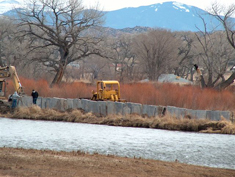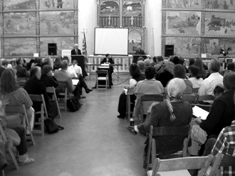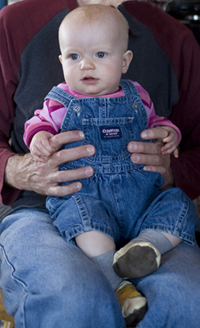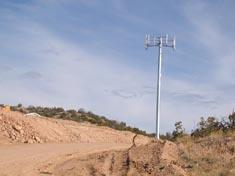 |
|
|
Volume XIII |
April 2008 |
Number IV |
|
|
Richard Cook: Levee Building on the Rio GrandeEditorial: Public Welfare, To Be or Not To Be By Mark Schiller and Kay MatthewsDepartment of Energy Holds Hearing in Española on Bomb Making at LANL By Kay Matthews |
Community Speaks Out: LANL Expansion Proposal By Mark SchillerFederal Communications Commission Holds Public Hearing on Chimayó Cell Phone Tower By Kay Matthews |
Richard Cook: Levee Building on the Rio GrandeSome folks in the Lyden/Velarde area of northern New Mexico wondered what was happening on the east side of the Rio Grande when workers started erecting a concrete and dirt filled flood protection levee on the bank of the river. Turns out it is Española businessman Richard Cook's land, and to date, three sections of barrier have been built that could channel the runoff flow of the river away from Cook's property and onto property and homes on the west side of the river.
Richard Cook's crew erecting the concrete and dirt filled barrier next to the east shore of the Rio Grande near Velarde Russ Shinn, who lives in the Lyden/Ancon area, contacted the Army Corps of Engineers in Albuquerque and engineer Jim Woods visited the site. It was Woods' opinion that the levee was not under the jurisdiction of the Corps because it is not built in the river (as you can in the photograph, it is in close proximity to the river bank) or in a wetland and suggested Shinn contact Rio Arriba County. Shinn had better luck with the County: Gabriel Boyle of the Planning and Zoning Department visited the site and his department issued Cook a Notice of Violation of the Flood Plain Ordinance (all counties must have flood plain ordinances that comply with federal guidelines). Cook was given five days to respond. His lawyer told Boyle that the levee would not channel water onto the west side of the river because there are outlets at both ends of the barrier, which he contends have the capacity to carry any excess flood waters away from the river. According to Boyle, the county will require that Cook demonstrate that the structure will not raise the base flood elevation of the river one or more feet or will find him in violation of the Flood Plain Ordinance. While Shinn was happy with the County's decision, he wrote the Corps a letter objecting to its decision that this issue is not in its jurisdiction. Shinn believes that the levee will directly affect both the river and the adjacent wetlands and acequias, and has, in effect, "managed or impeded natural water flows within the 100 year floodplain." Boyle suggested it would have expedited the process if community members had contacted local authorities first. He noted that the County is acting quickly and will do whatever is necessary to make sure that Cook is in compliance. Cook's challenge to the 2003 state statute that allows acequia commissions to review any proposed transfer from their acequias and deny the transfer if it would be detrimental to the functioning of the acequia system is slowly wending its way through the court system (see La Jicarita, October 2007). The attorneys who represent the San Jose de Hernandez Community Ditch and La Acequia del Gavilan submitted their brief to the New Mexico Court of Appeals on March 13 and Cook has 45 days to respond. Acequia attorneys then have 20 days to respond to that, and the court may or may not order oral arguments. After that, the court may take months to a year to render an opinion. Editorial: Public Welfare, To Be or Not To BeBy Mark Schiller and Kay MatthewsIn last month's issue of La Jicarita News Kay wrote an editorial, "Taos Regional Water Plan Hijacked by the Powers That Be," in which she claimed that the Interstate Stream Commission (ISC), which oversees the regional water planning process, helped orchestrate the takeover of a grassroots planning process by the entities in the region who want to buy and sell water rights on the open market with no oversight. Lynn Montgomery, a member of the Water Assembly, the non-profit group trying to implement the Middle Rio Grande Regional Water Plan, sent the editorial out on the Assembly's listserve, where it apparently raised a ruckus with some of the members. John Brown, who is the editor of the Water Dialogue, wrote a letter objecting to Kay's claim that the ISC doesn't want implementation as part of the regional plans and doesn't want public welfare to apply to a water management strategy that encourages water transfers from agricultural lands to urban areas. Steve Harris, founder of Rio Grande Restoration and owner of a commercial rafting company, called Kay's editorial "sour grapes." In response, Lynn, who is an acequia mayordomo in Placitas, and longtime water activist (his protest of a transfer of agricultural water rights from Valencia County to a subdivision in Placitas went all the way to the New Mexico Supreme Court), quit the Water Assembly. Lynn had many other reasons for quitting, but in his letter to Steve Harris he stated: "The law, and the survival of traditional cultures and agriculture cannot be ignored. The Taos Plan has this as its center, which has been surgically removed by those intent on destroying these so they can 'grow' and continue the expansion of their revenue coffers. The Plans are created by the public. What happened in Taos was a complete rejection of the desires of the public and an attitude of 'we can take all the water we want regardless of the consequences.'" While John concedes that the ISC may have capitulated to developmental interests in the Taos Regional Water Plan, he believes that "generally" the ISC is not "in bed" with development interests. He suggests that "state water policy administrators are seeking to avoid conflict, and especially the litigation of competing claims on a scarce resource, which they're anxious not to get in the middle of . . ." because they lack data and don't have the resources. We believe John is bending over backwards to give the ISC the benefit of the doubt. Although State Engineer John D'Antonio told the Water Dialogue in 2004 that he would be "guided by regional definitions of public welfare," at the November 28, 2007 hearing before the ISC on the Taos Regional Water Plan, he dismissed our concerns that the public welfare implementation component of the plan was in danger of being deleted from the plan by members of the plan's steering committee (Town of Taos, Questa, Red River, Taos Ski Valley, the water and sanitation districts, Taos Pueblo, and the Taos Valley Acequia Association) who rarely participated in the process until they felt their ability to market water might be jeopardized. He asserted that the current process, whereby water rights holders can protest water transfer applications on the basis of impairment, conservation, and public welfare, is perfectly adequate. He said this, despite the fact that the state has never established any criteria for determining what is in the public welfare, which the State Water Plan mandated the 16 regional water planning groups to determine for themselves. John Brown does acknowledge that the Taos Public Welfare Committee lacked the political clout to keep implementation on the table, and suggests lawmakers provide advisory review authority and resources for them to operate more effectively. But let's be painfully honest here and admit that the state bureaucracies and special interests that are actively involved in water marketing are not only "in bed" with each other but are oftentimes the same people, in revolving door succession, getting the government contracts and moving the water from the Middle Rio Grande agricultural lands to Albuquerque and Santa Fe. John had the decency to send a copy of his letter to the Assembly to La Jicarita News. Steve Harris, on the other hand, took his pot shots behind our back. The most disturbing thing about Harris' position is that he was a member of the Public Welfare Committee and knows full well the underhanded tactics that were used to scuttle the public welfare implementation program (see La Jicarita 2007 September, November/December). Although he accuses Kay and Michael Jensen of Amigos Bravos (who also wrote a letter to the Assembly stating "the ISC/OSE never wanted to have public welfare applied to intra-state water transfers and is perfectly happy passing the buck to the Regional Water Plans, as long as they don't do something crazy like actually developing an implementation plan that is in step with the 'values' contained in the Public Welfare Statement") of being "disingenuous." He suggests "Why not accommodate their [Town of Taos*, etc.] concerns, if it leads to the adoption of a workable Regional Water Plan?" Workable for whom? Apparently it serves Steve's interests, but what about the acequias in the northern and southern parts of the county that are vulnerable to water transfers to fulfill the terms of the Abeyta Settlement, whose parties include some of the same folks who scuttled the public welfare implementation program. The choice isn't between what Steve terms "great rhetoric and no implementation or bad rhetoric and actual implementation," it's between implementing a plan that grassroots representatives from throughout the planning area spent four years developing to protect, conserve, and equitably distribute our most precious resource, and allowing politically and economically powerful special interests to co-opt the process and slander members of the Public Welfare Committee at the same time. Yes, Steve, the process was hijacked, and no amount of your rhetoric will change that fact. * Now that the town has elected new members to the City Council and fired city manager Tomás Benavidez, hopefully it will work with the County to pass a public welfare implemenation ordinance. Department of Energy Holds Hearing in Española on Bomb Making at LANLBy Kay MatthewsA demonstrative crowd of norteños filled the San Gabriel Misión y Convento in Española to comment on the draft Complex Transformation Supplemental Programmatic Environmental Impact Statement (SPEIS; see below for a more detailed accounting of what the document proposes), which proposes to expand the production of plutonium pit "triggers" for nuclear weapons at Los Alamos National Laboratory (LANL). The diverse crowd - Hispano, Native American, Anglo, old, young - clapped and cheered the majority of speakers (70 people signed up to speak) who told the National Nuclear Security Administration (NNSA, the agency that runs LANL, as well as the other Department of Energy nuclear facilities), that it's time to change the mission at the Lab.
The most important message that emerged from the hearing is that while the economy of northern New Mexico has been based upon LANL employment for many years, the reality of what that employment has cost the people in terms of social and physical ills is becoming more and more apparent. Many of the speakers mentioned one of the most egregious statistics, that northern New Mexico has one of the highest rates of deaths due to drug overdoses. Carol Miller, Independent Party candidate for Congress, asked, "If there has been such a strong economic impact from the Lab, why are we always at the lowest part of the economic scale?' Española Mayor Joseph Maestas, who has consistently spoken out against the Preferred Alternative of the SPEIS that would increase pit production at LANL (he attended the hearing as an individual but sat through its entire four hours listening to the testimony) stated, "I'm extremely sensitive to the economic impact of LANL on my community . . . but a change is long overdue. . . . The Cold War paradigm put forth in this document is obsolete." As reported in last month's La Jicarita News, the city of Española is moving forward on two economic development strategies in conjunction with Northern New Mexico Community College (see page 5 as well). Other New Mexico public officials weighed in as well. A representative from Senator Jeff Bingaman's office told the crowd that the meeting scheduled in Española had to be added to the schedule at the request of the mayor and the congressional delegation, and that the senator had formally requested that the comment period be extended for 90 days. John Goldstein spoke for New Mexico Environment Department Secretary Ron Curry, stating the ED has submitted formal comments opposing the Preferred Alternative and emphasizing there should be no consideration of new pit production until LANL has complied with the 2005 Consent Order for fence to fence clean-up. A number of scientists testified in favor of the Preferred Alternative, including several who currently work at LANL. One said he was part of a new generation of scientists "who has the same goals as many who have spoken here but disagrees on the means of getting there [reducing the need for weapons manufacture]." He cited his work at Rocky Flats, where he and a group of scientists remediated 95,000 tons of contaminated soil. Of course, until its closure in 1989, when it was declared a Superfund site because of the extent of the contamination, Rocky Flats was the site of the production of plutonium pits. Several subsequent speakers addressed that issue: if LANL becomes the site of all the pit production for NNSA facilities we will see the same kinds of air, water, and soil contamination that shut down Rocky Flats. The project manager of pit production at LANL spoke next and listed his "credentials," or what he deemed gave him the scientific and moral authority to support the Preferred Alternative: a Princeton educated man who chooses to live in Los Alamos with his Japanese wife and children, whose in-laws lived near Nagasaki when the atomic bomb was dropped during World War II and felt the effects of the fallout. What he said next had the effect of dropping a figurative bomb in the room, leaving many quite disturbed: "My in-laws support the work that I do." In Joseph Masco's book, The Nuclear Borderlands (see review, La Jicarita News, May 2007), Masco tries to explain the kind of thinking this scientist displayed. Because many nuclear weapons scientists have never actually conducted or witnessed a nuclear detonation, and the weapons themselves are designed never to be used, they become a "technoaesthetic," or an aesthetic-intellectual project that becomes normalized and depolilticized in the scientists every day work. Masco explains: "[From the scientist's perspective] Los Alamos weapons scientists are no longer working to put themselves out of business, but should see themselves as proprietors of a permanent part of an American world system, one that requires continuing investments and innovation-because, after all, when is 'art' done, or we might add, 'U.S. security complete?" But the next speaker, anti-nuclear activist Sasha Pyle, put the issue into political perspective: "This is about a sweeping national policy with global consequences." She explained that the current administration is trying to rush this environmental impact statement through before a new administration completes a new Nuclear Posture Review in 2009 to establish future United States arms control objectives. The SPEIS is the latest step in the National Environmental Policy Act (NEPA) process that began with scoping for DOE's proposed Complex Transformation, previously referred to as Complex 2030 (or "Bombplex") in late 2006 and early 2007. Of the 34,000 comments the DOE received, 90 percent of them objected to a "transformed Complex . . . expected to be safer, more secure, and less costly to maintain," and the fact that the programmatic environmental impact statement didn't include a disarmament alternative, in compliance with the 1970 Nuclear Non-Proliferation Treaty. The DOE is trying to complete the NEPA process this summer and publish a Record of Decision before the Bush administration leaves office. The National Nuclear Security Administration's statement of purpose in the Complex Transformation SPEIS is to "Create a smaller, safer, more secure, and less expensive enterprise that leverages the scientific and technical capabilities of the workforce, and meets national security requirements." In order to do this, the agency is proposing to restructure Special Nuclear Material Facilities and Research and Development and Testing Facilities. The Preferred Alternative in the SPEIS, referred to as "Distributed Centers of Excellence," would move the major functions required to support the nuclear weapons stockpile to a consolidated plutonium center at LANL. Los Alamos would provide up to 80 pits per year (with a capcity for many more) at its upgraded Plutonium Facility and with construction of the Chemistry and Metallurgy Research Replacement Nuclear Facility. Uranium Manufacturing and Research and Development would continue at the Y-12 site in Tennessee; and Assembly/Disassembly/High Explosives Production and Manufacturing would remain at the Pantex site in Texas. Despite requests from the New Mexico congressional delegation, NNSA refused to extend the comment period, but will consider comments received after the April 10 deadline "to the extent practicable as it prepares the Final Complex Transformation SPEIS." Public comment can be submitted by regular mail to: Ted Wyka, NNSA, Office of Transformation NA-10.1, 1000 Independence Ave., S.W., Washington, D.C. 20585; via e-mail at complextransformation@nnsa.doe.gov or www.complextransformationspeis.com.
|
ANNOUNCEMENTSDixon Community Seed Exchange Sunday April 13th, 10am-2pm Embudo Valley Community Center Dixon, NM (Next to the Coop Market on NM 75, 2 miles from the junction with NM 68) Join us to share and exchange seeds for the coming season. Flowers, herbs, natives and food crops. Heirlooms, rare gems, donated commercial seed, local varieties. If you have any seeds to share, bring them. If not, just bring a smile, and some small bags to take your treasures home. Last year we welcomed nearly 300 growers and seed savers, and more than 300 varieties of different seeds. Open to all, admission is free. Contact: Adam Mackie, 505 579-9679, papaloquelites@yahoo.com • Amy Goodman of Democracy Now! & her brother, author David Goodman, are speaking in Rio Grande Hall, Civic Center Drive, Taos, on Saturday, April 19 at 7 pm, about their new book, Stopping the Madness: Ordinary Heroes in Extraordinary Times. Doors are open 6:15 pm. Honoring our own Ordinary Heroes: Activists Margarita Garcia & Kathy Sanchez at 6:30. Tickets: Kultur Café South: Advance: $10 Adults, $8 Youth 18 & under. Tickets $2 more at the door. For more info call 575-758-9791. A benefit for Cultural Energy and KRZA Radio. • A forum on "Nuclear Bombs in Our Backyard: How expanded Plutonium Pit Production at Los Alamos National Labs Affects You," will be held on Wednesday, April 23 at 7 pm at the Taos Community Auditorium in Taos, next to Kit Carson Park on Paseo del Pueblo Norte. The evening will include an interactive discussion between a panel of anti-nuclear experts and the audience, plus excerpts from a documentary on the history of nuclear weapon development in NM, "Do It for Uncle Graham." Panel members include: Jessica Wilbanks, Faithful Security; Joni Arends, CCNS; Jay Coghlan, Nuclear Watch NM; Sheri Kotowski, Embudo Valley Monitoring Group; Candy Jones, documentary director/producer; and Gilbert Sanchez, past governor of San Ildefonso Pueblo. Music will be provided by Indigie Femme, a duo of Native women singing songs of healing and transformation. This event is free to the public; suggested donations of $5-10 are welcome. Call Gail Raborn for more information: (575)751-7310. • New Mexico landowners at any income level can qualify for a state income tax credit of up to $250,000 by placing a permanent conservation easement on their land agreeing not to develop it. If the credit is not used it can be sold for around 80% of its face value. This means a cash payment of up to $200,000 simply for the public service of promising never to develop some or all of your land. For more information contact TAOS LAND TRUST at 575-751-3138 or info@taoslandtrust.org; or visit www.taoslandtrust.org. In the May issue of La Jicarita News Daniel Claussen of the Santa Fe Conservation Trust will explain the tax credit in detail.
|
Home | Current Issue | Subscribe | About Us | Environmental Justice | Links | Archive | Index
Copyright 1996-2006 La Jicarita Box 6 El Valle Route, Chamisal, New Mexico 87521.





